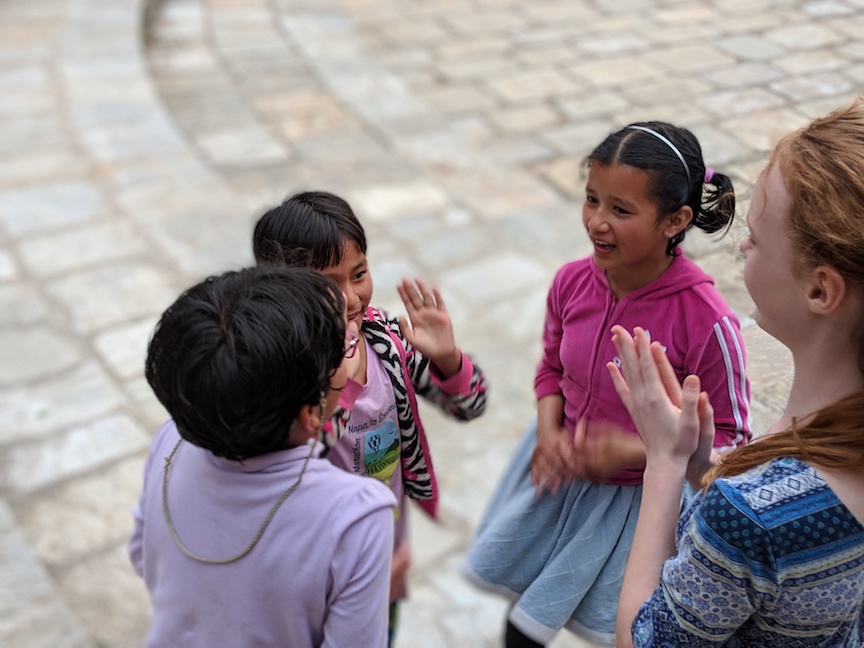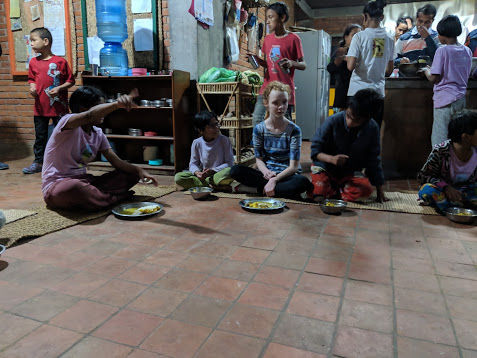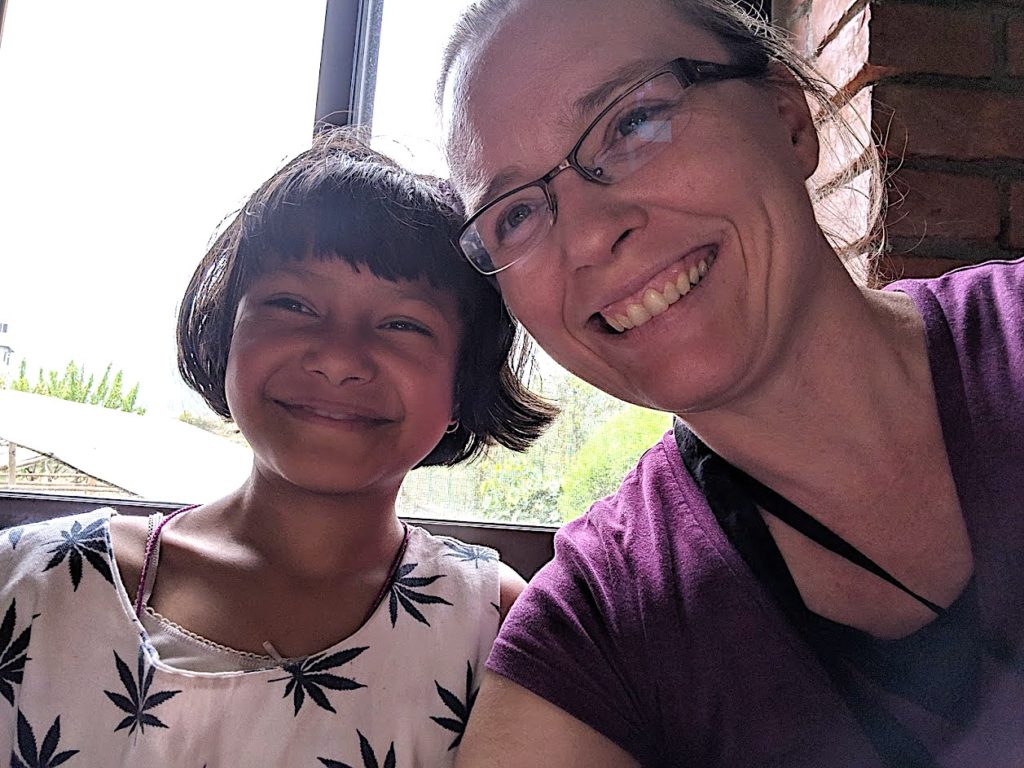Ama Ghar visitor Kate Rademacher shared this wonderful story with us – enjoy – it will make your day…
“This week is the anniversary of our former foster daughter’s arrival in our home. She was placed with us the day before the 4thof July holiday.
The first ten minutes were awkward as we played a game with her on the rug and introduced her to our daughter, Lila. But then we all began to relax. Over the next few hours and days, we fell in love with the girl, and she seemed to fall in love with us. Within forty-eight hours, she began calling us, “Mommy” and “Daddy,” and although we made half-hearted attempts to discourage this, she never stopped referring to David and me that way. We felt like a family. She stayed at our home for nine months, and then she left.
Now we haven’t seen her in nearly two years. Next month she will celebrate her seventh birthday, but we won’t be there for the party and we aren’t able to send her a gift. The girl’s therapist and her family believe that it is better if we don’t have contact with her – at least until she’s much older. They know how deep our connection was with one another, and they want her to be able to “move on.” We think about her every day. My heart has felt broken over the loss, even though I know it is the role I signed up for when we became foster parents. Letting go has not been easy.
So earlier this year, when we visited Ama Ghar, a permanent care home located in the Kathmandu valley in Nepal for children who are orphaned or whose parents can’t care for them, I was caught off guard. I fell in love again, and we were only there for two days.
My experience reminded me of a person who is recovering from a painful break-up. When you are grieving, you don’t know if or when you’ll ever find someone else to fill the hole in your life. You’re skeptical that you’ll ever fall in love again. But then when you experience the flare of love with someone else – even if briefly – it shows you that your heart is resilient and of course the hole can be filled.
When we arrived at Ama Ghar, we volunteered to help with maintenance projects, but there weren’t many concrete tasks the staff needed us to do. Instead, they invited us to spend our time hanging out with the kids. We played clapping games with the younger kids and soccer with the older ones. I pushed kids on the swing set, and my daughter, Lila, climbed with them on the jungle gym. We ate afternoon snacks together, and then we helped with homework and read picture books.

I fell in love with several of the kids almost immediately. One of them is Pooja, who is incredibly intelligent. Nearly fluent in English, she and I sat together while she studied for her final exams of the semester. I was shocked at the difficult math and history problems that this ten-year-old girl answered without hesitation. She grinned at me happily as I remarked over each problem she completely correctly.
And there is Bina, a fifteen-year-old girl who became fast friends with Lila. Lila is thirteen, and it was her first time traveling outside of the US. I had worried before the trip that it would be exhausting and overwhelming for her. But she did great during our two weeks in Nepal, and she now says the visit to Ama Ghar was her favorite part of the trip. I found Lila and Bina giggling and tickling one another after we had been there for just a few hours. “I know it sounds weird,” Lila told me later that night. “But I feel like we made a real friendship, even after just that short time together.”

While we were there, we also got to know Bonnie, the director. My experience over the past two decades of working in the nonprofit sector has taught me that the quality of social services usually comes down to the skill and integrity of the people running a program. In my professional work in public health, we talk about the need to implement “evidence-based” interventions. But in my experience, the reality is that if you don’t have kind, thoughtful people implementing a program, it will typically fall flat. Bonnie and the team at Ama Ghar struck me as top-notch – they are intelligent, dedicated, steady and loving. Just the kind of adults you’d want caring for “disadvantaged” kids. And the physical building is impressive with open, airy communal spaces downstairs and bunk rooms upstairs for the kids. Thankfully, the buildings at Ama Ghar were constructed well; they were among the few in the region that survived the devastating earthquakes in 2015.
While I was at Ama Ghar, I had fantasies of scooping up one of the girls and bringing her back to live with us in the U.S. While of course this was impractical on every level, the tightness I felt in my chest as I looked at the kids was real. But even if it had been a realistic possibility, I was struck by the deep ways the kids at Ama Ghar are embedded in Nepali culture and community.

The second day of our visit was a weekday, and the kids headed off to school in the morning. After the kids got back in the afternoon, a group of them laid out a pile of cushions in one of the doorways. They sprawled out together, giggling and chatting. One of the staff members sat with the group, her backs leaned up comfortably against the wall while she brushed one of the girl’s hair. The relaxed sense of connectedness and belonging was wonderful. I wondered if that kind of easy rapport between both kids and adults is the norm in other “children’s homes.” A few hours later, at dinner time, we ate together on mats on the floor. We each had a metal plate with piles of Dal (the traditional lentil dish), rice, and curried goat. The food was delicious. The kids ate the traditional Nepali way, scooping up the rice and lentils with their right hands, continually reshaping the mound of food so it would be easier to grab and lift to their mouths. I ate with a fork and a spoon. As I looked around, I thought to myself that even if I could whisk a child or two away to a “privileged” life in the U.S., I am not sure I would want to deprive them of the Nepali cultural and community they have at Ama Ghar.
My family and I spent two weeks in Nepal, and we loved the entire trip. But now that we’re back home, Ama Ghar is the only place I miss. I hope we can go back one day. In the meantime, we will be making donationsto support the work of Ama Ghar; they don’t receive any government funds and rely entirely on contributions from donors – mostly based in the US and Europe.

On the evening before we left, we taught a group of kids how to play the American game, Duck-Duck-Goose. It was a big hit. After the kids got the hang of it, I told them that they could swap out the words, “duck” and “goose” for any other words they chose. I demonstrated by touching their heads as I walked around the circle. “Tiger,” “Tiger,” “Tiger,” I said in turn. Then suddenly I shouted out “Monkey!” and the child I touched was “it.” Shrieks of laughter followed me around the circle until I reached the empty spot and plopped down into place. The kids tried different versions for themselves with enthusiasm. Pretty soon the kids started using Nepali words instead of English. Lila and I didn’t understand their meaning, but the language of fun and friendship is universal, and we always knew when we were “it.” — Kate Rademacher
—-
